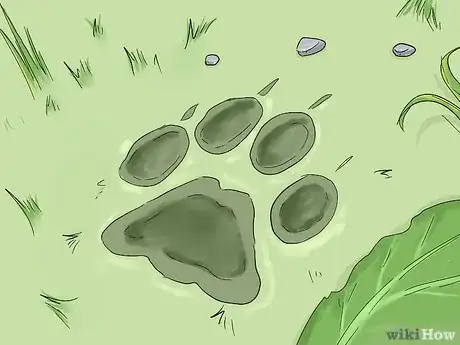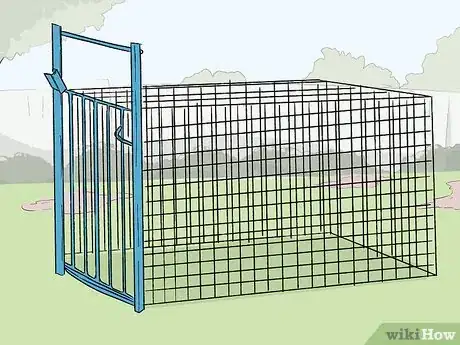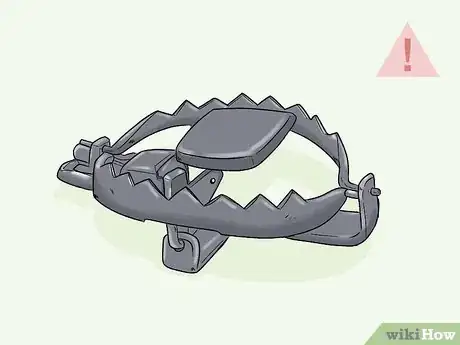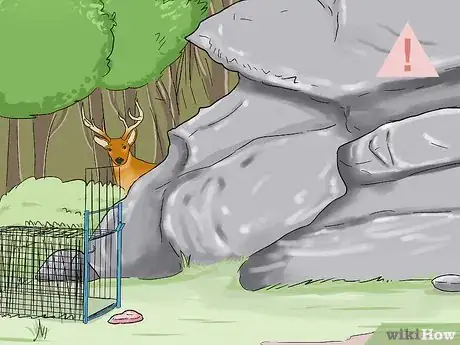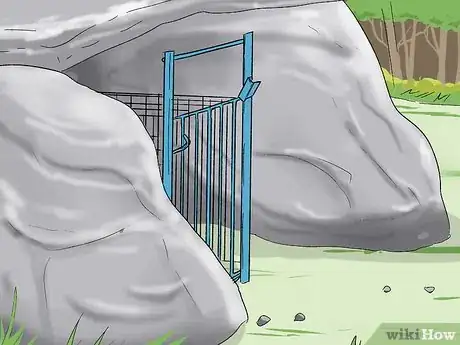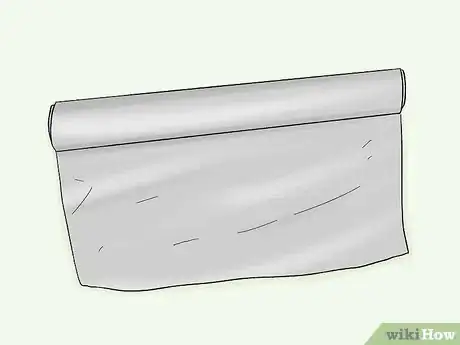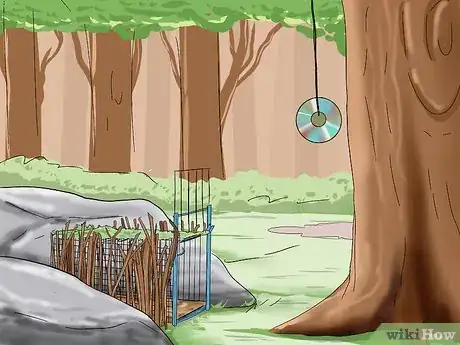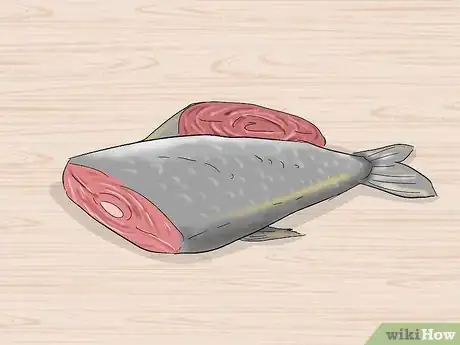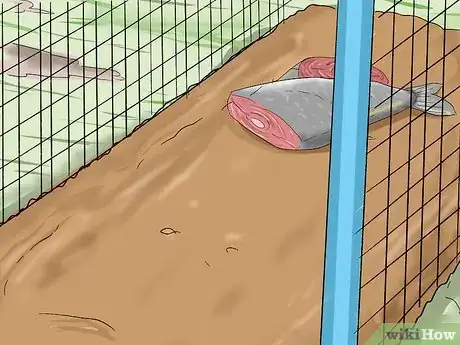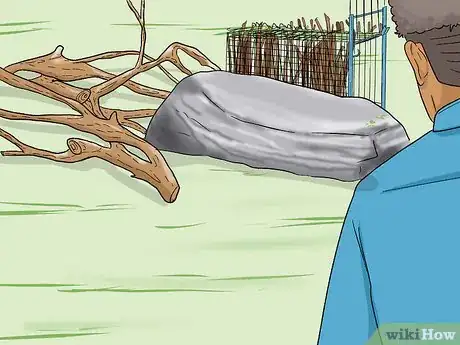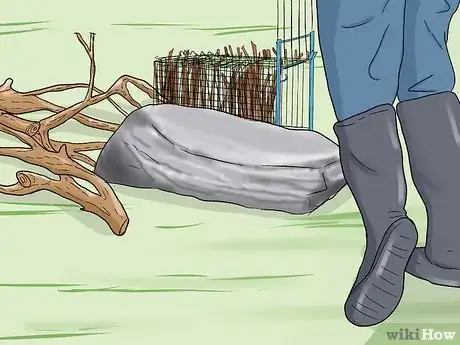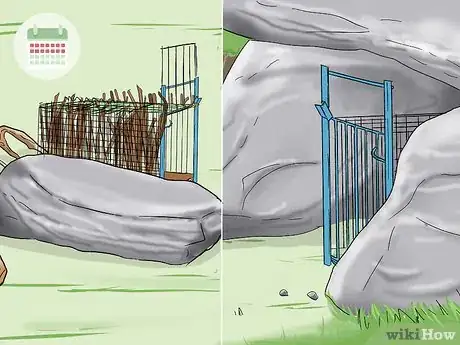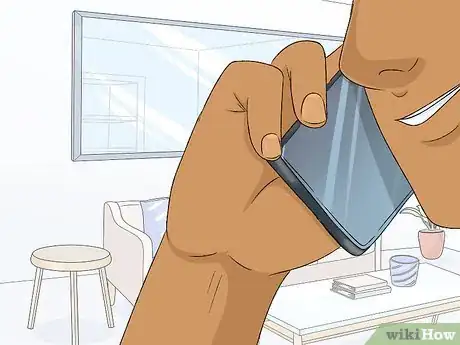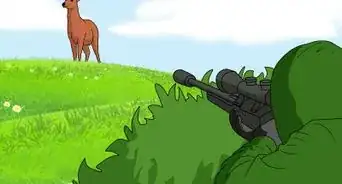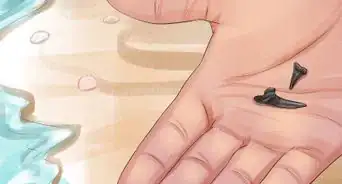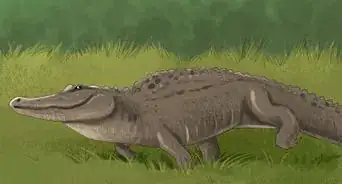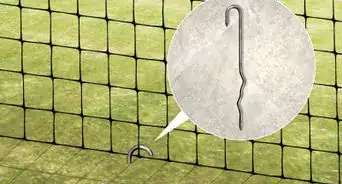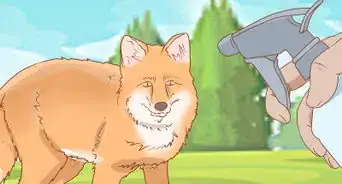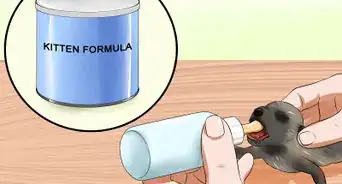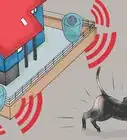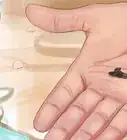This article was co-authored by wikiHow Staff. Our trained team of editors and researchers validate articles for accuracy and comprehensiveness. wikiHow's Content Management Team carefully monitors the work from our editorial staff to ensure that each article is backed by trusted research and meets our high quality standards.
There are 18 references cited in this article, which can be found at the bottom of the page.
This article has been viewed 14,354 times.
Learn more...
Since they look like bigger versions of your ordinary house cat, bobcats are fun to spot in the wild. They are brown-colored with pointy ears and a black, bobbed tail. They are normally shy animals that prefer to stay hidden, but sometimes they threaten small pets or even attack humans. Catching a bobcat takes a good trap, the right bait, and some patience. In some areas, you can also get a permit to hunt bobcats for their fur.[1]
Steps
Tracking a Bobcat
-
1Check local rules and regulations about trapping bobcats. Contact your state conservation office for more information. In the U.S. for example, all but a handful of states restrict bobcat hunting. If you plan on trapping a bobcat, you have to do it in a safe, humane way, and then release it within 24 hours. If hunting is legal in your area, apply for a permit at the conservation office.[2]
- Some areas have rules stating that you have to use rubber-jawed traps, for instance, and label them with your name and address.
- Watch out for permit requirements. You usually need a bobcat permit to hunt. You might also have to request a separate permit to use steel traps or hunt at night.
- States that allow bobcat hunting require you to register each pelt with the conservation office. In some places, the tags come with a bobcat hunting permit.
-
2Look in rocky, elevated areas for more chances to find bobcats. Bobcats can be found in a wide variety of areas, even in your own backyard! However, they prefer areas with a little more cover. Try checking out ledges, dry creek beds, cliffs, and rocky outcroppings. They prefer isolated areas they can look down on, but they can be found in other areas as well.[3]
- Some bobcats live in swamps or forests with long grass, bushes, and trees to hide in.
- Another spot to look is around abandoned buildings, especially if they don’t receive a lot of foot traffic or have grassy fields nearby. Bobcats go there to hide and hunt.
- Bobcats have been known to appear in small, rural towns, but they can even appear around large cities. There is plenty of food there, so you may be able to catch one without ever leaving your home.
- If you think a bobcat is visiting your home, then you can just set the trap in your yard. They also tend to visit open fields, so look there too if you have any nearby.
Advertisement -
3Search for wide, cat-like tracks left by bobcats. If you know where one likes to prowl, you have a good chance of catching one by setting a baited trap there. Bobcat prints consist of 4 toes and a wide, lower pad. They are bigger than house cat tracks, but shorter than dog or coyote tracks. They are usually around 22 in (56 cm) long and 2 1⁄4 in (5.7 cm) wide.[4]
- A bobcat’s back paws are slightly smaller and rounder than their front ones.
- Lynx and cougar tracks are much larger. Bobcats are just a little bit bigger than house cats, so their tracks aren’t that much bigger.
- The only downside to following tracks is that bobcats travel along a wide hunting area. If you’re tracking one out in the wild, you might have to wait a while for it to come back.
-
4Watch for gray, 4 in (10 cm) long scat or other signs. Their poop is about 3⁄4 in (1.9 cm) wide with rounded ends. It looks segmented and may have ground-up bones in it. Bobcats also partially cover it by scratching up leaves and dirt like a pet cat in a litter box. Bobcats also make scent mounts about 6 in (15 cm) tall covered with the same nasty ammonia smell regular house cats leave behind.[5]
- Mountain lions leave larger poop. Foxes leave smaller, pointer poop that often has fur and bones in it. Coyote poop is the same size but darker and with fur, bones, or berries in it.
- Watch out for possible food sources. Bobcats eat meat only, so you may see partially-eaten animals, but they won’t touch fruit or anything else.
-
5Look for any rocky ledges in the area. Bobcats can be found in a wide variety of places, but they are most common around ledges. Look for signs of tracks or their dens there. If you can, set your traps nearby. You usually won’t have to wait as long to lure one in.[6]
- They like rocky ledges because it’s safe and high up. They can see anything coming toward them, including whatever they are hunting.
- Bobcats also live in swamps, bogs, forests, and other areas, so you can still catch one if you don’t live near a ledge. Some of them come into towns to search for food, and you can set a trap in your yard to lure them in.
Choosing and Setting a Trap
-
1Select a cage trap to humanely catch a bobcat and relocate it. Cage traps are a great choice for inexperienced trappers, and they don’t hurt animals at all. Try getting a heavy wire cage that is at least 3 ft (0.91 m) long, 2 ft (0.61 m) wide, and 4 ft (1.2 m) tall. Pick one with a pressure plate called a treadle. When the bobcat steps on the plate, the door slams shut, and you don’t have to be anywhere near the cage to lock it.
- Cage traps don’t harm bobcats and they won’t harm any other animals that stumble in. If you’re just trying to relocate a bobcat, this is the best choice.
- The second-best type of trap is a rubber-jawed paw trap. When the bobcat steps on the trap, the jaws close around its paw. This trap is much easier to hide, but it also can cause a lot of stress for the stuck bobcat.
-
2Refrain from using lethal traps unless they are legal in your area. Get permission from a conservation office first. These traps can be inhumane to animals and dangerous to inexperienced trappers, so set them up with caution. If you absolutely have to take out a bobcat, you could use a conibear, or bodygrip, trap. This kind of trap clamps down hard, killing the animal quickly in most cases.[7]
- If you’re looking for the least harmful trap, use a rubber-jawed paw trap. It keeps the bobcat still so you can shoot it from a distance, killing it as painlessly as possible.
- Lethal traps should only be used in the wild. They are dangerous and can easily trap pets, for instance.
-
3Keep traps away from areas with other animals. Keeping foxes, coyotes, and other animals out of your trap is difficult if they are active in the same area. The best way to do this is to use a non-lethal trap and monitor it all the time. Make sure your traps are well-hidden near areas where you know bobcats live. Use fresh meat for bait, since bobcats won’t go after spoiled meat. If you think they have moved on, pack up your trap so nothing else ends up in it.[8]
- For example, if you put a trap in your backyard, you should only have it out at night, when bobcats are most active. Remove the bait and close it up in the daytime.
- If you happen to catch something other than a bobcat, free it as soon as possible. Report injured animals to the nearest wildlife department. Wait for help instead of releasing them back into the wild.
-
4Place the trap in a sheltered spot near the tracks. Try to find a spot where you can tuck away the trap to hide it. If you’re able to find a spot with a few trees, branches, or rocks, you can use them to set everything up. Turn the trap so the open end is facing outward, toward the spot you expect the bobcat to come from. Keep the closed end backed up against a tree trunk, cliff, or something else.
- You don’t have to find an enclosed area to place your trap, but it helps lure the bobcat in. Bobcats are cautious. The more natural the area looks, the more likely a bobcat is to wander toward it.
- Do the best you can to hide the trap. If you aren’t able to cover it extremely well, put extra effort into getting quality lures and bait.
-
5Cover the floor of the trap with soil. Bring a small shovel with you. Take some dirt from a nearby area away from the trap. Cover up as much of the metal floor as possible to blend the trap in with its surroundings. The dirt will also help stabilize the trap so the bobcat can’t knock it over.
- Grass is also useful for covering up mesh flooring or a paw trap pad, but don’t dig up anything unless it’s legal to do so. Instead, use dirt, sticks, or even rocks.
- If you’re using a spring-loaded trap, make sure it’s sensitive enough to activate when the bobcat steps on it. Some small traps won’t trigger, especially when they are covered.
-
6Put branches over the cage to help cover it. Do what you can to camouflage the trap. For instance, take some big branches and lean them against the cage. Fill in additional space with leaves, sticks, and loose grass collected off of the ground. Hide as much of the metal as you can, but don’t cover the cage’s opening.[9]
- If you’re in an area without a lot of ground covering, do the best you can. Find a sheltered spot close to the bobcat’s territory, such as a nearby cliff. Cover the trap’s floor first, then use anything else available to cover the rest.
- If a bobcat sees an unusual object like a big, metal cage, it becomes cautious and keeps its distance. A bobcat is more likely to approach a well-hidden trap.
Baiting a Trap
-
1Choose a shiny object like aluminum foil to use as a lure. Cut a strip of foil about 1 in (2.5 cm) wide. Poke a hole through one end and slip a length of fishing wire through it. You can use the wire to hang the lure near your trap. If you have enough room, you can position several lures to catch the bobcat’s attention.[10]
- Christmas tinsel also works well. Alternatively, use a shiny piece of metal or a colored strip of cloth.
- Bobcats are just big cats. If you have ever had a pet cat, you might have seen how they can’t resist unusual things that catch their attention. Bobcats are no different.
-
2Hang the lure somewhere near your cage. Take advantage of nearby trees, for instance. Wrap the wire around the tree about 2 ft (0.61 m) off the ground. Knot it and make sure it’s secure. As long as the lure reflects light and flutters in the breeze, a bobcat is bound to see it.[11]
- Position the lure near your trap but not over it. It is there to lure the bobcat into the area, not into the trap. It could cause them to avoid the trap or spring it too early.
- If you don’t have trees nearby, look for other opportunities. For example, you could try placing a nail in a rock, then tying the lure to it.
-
3Choose a smelly piece of meat to use as bait. Bobcats enjoy meat, but they don’t have a great sense of smell. One of the simplest ways to overcome this is with a fish that has a strong odor, such as sardines or mackerel. If you don’t have fish available, select a spiced meat, such as hot dogs. You don’t have to cook the bait, since bobcats eat raw meat in the wild.[12]
- Some trappers age meat to give it a stronger scent. You can do it by wrapping a quality piece of meat in cheesecloth and setting it in the refrigerator.
- Animal parts are fine if they are legal to use in your area. You could use a piece of squirrel meat, for instance, even if it still has some fur or bones. Bobcats eat raw meat from animals like rabbits, rodents, and birds.
-
4Place a piece of bait in the back of the trap. If you’re using a cage trap, place the bait all the way in the back, past the trigger for the door. That way, the bobcat will step on the door trigger as it walks past. Make sure the food stays inside the cage, especially if you weren’t able to fill in the entire floor. Keep it centered and easily detectable.[13]
- If you’re using another kind of trap, place food inside the trap so the bobcat has to walk into it. Some people also hang food or lures over paw traps to tempt the bobcat over.
- You could also spread some food around the trap to help lead the bobcat to it. For instance, scatter some right in front of the trap. Keep in mind, however, that other animals may get to it first.
-
5Use a bobcat scent lure to help attract bobcats to the trap. Doing this is optional, but it can increase your chances of luring in a bobcat. Purchase a bottle of bobcat gland scent or even bobcat urine. Spread about 20 to 30 drops of the scent on the ground close to the trap’s entrance. You can also place a few drops nearby, such as on clumps of grass and trees.[14]
- A quality scent lets the bobcat know that the area is safe. The scent means that another bobcat passed through there, so they come to inspect it.
- If you happen to have animal parts, like bones, fur, or feathers, you can also place them near the trap to use as a lure. This isn’t legal everywhere, though.
- Scents are available online and are available at many hunting supply stores.
Trapping a Bobcat
-
1Cover your tracks after you’re done setting up the trap. Take a quick look around the area. Notice anything that looks out of place. Make sure your trap is well-covered, for instance, then spread dirt over visible footprints. If you flipped over a rock, put it back the way it was. Leave no stone unturned.[15]
- Anything that looks out of the ordinary could scare away bobcats, so be thorough when cleaning up.
- Don’t leave anything behind. If you have trash or supplies, take them with you.
-
2Check the trap every morning to see if it’s still active. Bobcats roam around at dusk and sunrise, so try to get back to your trap right away. If you don’t see anything in it, look to see if the bait is gone. Open the trap back up and restock it with fresh food. Return to it each day in case anything changes.[16]
- Don’t leave an animal sitting in a trap for long! You will end up with one scared, hungry, cranky cat. It’s also illegal in most areas to keep animals captive for more than 24 hours.
-
3Wait 2 to 4 weeks before moving the trap. Most traps are fine for about 3 weeks on average when left undisturbed. If you don’t catch anything by then, look around at your setup. If you still expect a bobcat to come through the area, then replace the bait and reapply the scent. Make sure the trap is still well-hidden and that nothing about it would scare a bobcat away.[17]
- A male bobcat’s territory is 30 sq mi (78 km2) or more in size, so don’t worry if you don’t catch one right away. If you wait long enough, the bobcat will eventually come back.
- During rainy periods, take more time to refresh your trap. The rain could wash away your preparations. Scents usually have to be reapplied within 7 days.
-
4Call your local wildlife agency if you catch a bobcat. Let them deal with handling the bobcat. You could also call a professional animal removal service or a big cat animal sanctuary, if you have one in your area. Bobcats can be dangerous, so don’t handle them yourself unless you have to. In most cases, you can’t safely put them back into the while on your own.[18]
- Bobcats have to be taken far away so they don’t come back, but that puts them in unfamiliar territory. They could be attacked by other animals, get hit by a car, or otherwise suffer if you just let them loose there.
- If you have to handle a caged bobcat, wear damage-resistant gloves, long pants, and a long shirt. Be careful to avoid bites and scratches.
- If you’re on your own property or have a bobcat hunting license, you can legally euthanize a bobcat. Shoot it in the head or heart so it doesn’t suffer.
Community Q&A
-
QuestionCan i make the bobcat my pet or best friend?
 MadDocGCommunity AnswerNot likely. Perhaps if you can find a Bobcat kitten before it opens its eyes, it might habituate to you. However, even then you might end up with a wild animal in your home when the animal matures. Generally, it is best NOT to try to domesticate a Bobcat.
MadDocGCommunity AnswerNot likely. Perhaps if you can find a Bobcat kitten before it opens its eyes, it might habituate to you. However, even then you might end up with a wild animal in your home when the animal matures. Generally, it is best NOT to try to domesticate a Bobcat.
Warnings
- Bobcats can be dangerous when they are hungry or scared. Stay away from wild bobcats and approach caged ones with caution while wearing damage-resistant gear.⧼thumbs_response⧽
Things You’ll Need
- Bobcat cage trap
- Aluminum foil or alternative lure
- Fishing line
- Meat, fish, or alternative bait
- Small shovel
- Bobcat scent (optional)
References
- ↑ https://www.azgfd.com/wildlife/livingwith/bobcats/
- ↑ https://cpw.state.co.us/Documents/RulesRegs/Regulations/Ch03.pdf
- ↑ https://nationalzoo.si.edu/animals/bobcat
- ↑ https://wdfw.wa.gov/species-habitats/species/lynx-rufus#living
- ↑ https://www.cserc.org/blog/what-scat-can-tell-you-about-your-wildlife-neighbors/
- ↑ https://www.fs.fed.us/database/feis/animals/mammal/lyru/all.html
- ↑ https://www.pgc.pa.gov/HuntTrap/TrappingandFurbearers/Documents/BMP%20Trapping%20Bobcats.pdf
- ↑ https://www.nj.gov/dep/fgw/news/2012/bobcat.htm
- ↑ https://www.youtube.com/watch?v=UOFoEee_IWM&feature=youtu.be&t=222
- ↑ https://www.nbcconnecticut.com/news/local/connecticuts-bobcat-population-flourishing/2200244/
- ↑ https://www.youtube.com/watch?v=gTzRN6N81UY&feature=youtu.be&t=144
- ↑ https://digitalcommons.unl.edu/cgi/viewcontent.cgi?article=1030&context=icwdmhandbook
- ↑ https://digitalcommons.unl.edu/cgi/viewcontent.cgi?article=1030&context=icwdmhandbook
- ↑ https://www.fwrc.msstate.edu/predator/frtrapping.asp
- ↑ https://www.asgmag.com/survival-skills/leave-no-trace-behind-hiding-your-tracks-101/
- ↑ http://www.urbancarnivores.com/laurels-blog/2013/3/5/how-to-catch-a-cat-part-ii-make-sure-you-have-a-question-and.html
- ↑ http://www.urbancarnivores.com/laurels-blog/2013/3/5/how-to-catch-a-cat-part-ii-make-sure-you-have-a-question-and.html
- ↑ https://www.azgfd.com/wildlife/livingwith/bobcats/
- ↑ https://www.thecolonytx.gov/158/How-to-Discourage-Bobcats-from-Your-Yard
- ↑ https://wdfw.wa.gov/species-habitats/species/lynx-rufus
- ↑ https://www.azgfd.com/wildlife/livingwith/bobcats/
- ↑ http://www.predatormastersforums.com/bobcat.shtml


